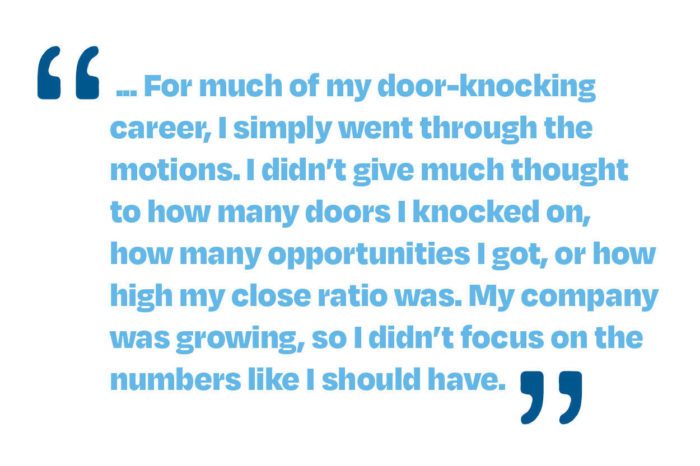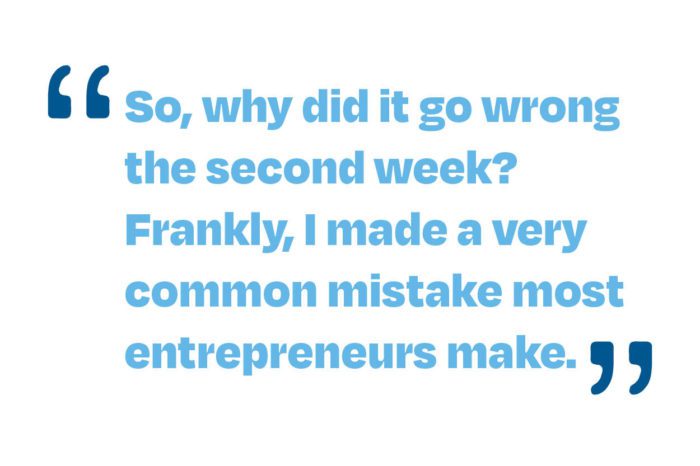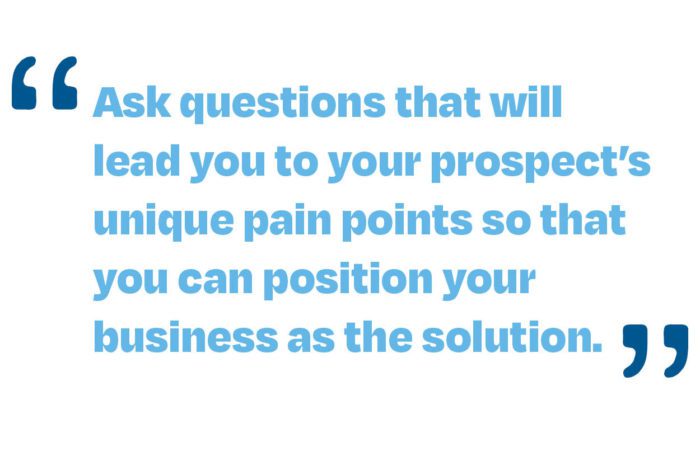How do you write sales scripts that sell?
In what feels like a lifetime ago (my early 20s), I owned a dry-cleaning pickup and delivery business. I didn’t own the dry cleaner; I just owned the routes and outsourced the dry cleaning. It was an interesting business model, and I had a decent amount of success with the sales scripts and methods I was using. I even coached and trained dry cleaners and other entrepreneurs on how to successfully start and run their own pickup and delivery business while improving sales and profit.

The way I marketed that business was unsophisticated, to say the least. We used pen and paper and literally went door to door, offering our free pickup and next-day delivery dry-cleaning services. This service should have been a no-brainer. About 90% of the time, we were the same price or better than if customers took their clothes in themselves. We picked them up on a Monday, for example, and returned them the very next day. The way you make good money in this business and maximize profits is to have lots of customers in a small geographic area. And at the time, door-to-door sales was the best way to make that happen.
I’ve personally knocked on thousands of doors. For much of my door-knocking career, I simply went through the motions. I didn’t give much thought to how many doors I knocked on, how many opportunities I got, or how high my close ratio was. My company was growing, so I didn’t focus on the numbers like I should have. I was playing small ball and thought, “Some weeks are good. Some weeks are bad. It is what it is.”

As I matured as an entrepreneur, I wanted to really build a business. I wanted to have something with systems and processes that was sellable. As I played around with sales scripts and marketing one day, I stumbled upon some game-changing scripts. Let me put this into perspective. A good week of knocking on doors at peak times (5:30–8:30 p.m.), 4 or 5 days per week, would average about 18 customers. As I started testing one new script, I saw my numbers go crazy. The first full week using my new script, I personally signed up 42 new customers. This was going to be so huge. Clearly, with these kinds of new customer sign-up numbers, I was going to be rich!
I was pumped for the next week of door-knocking to start, the opposite of how I normally felt. I confidently went out and started knocking. My first day back, I wasn’t getting the same number of sales as the previous week, but it was OK. It’s just how things roll some days, I told myself. By mid-week, I was questioning my sales scripts and wondering if I had just gotten lucky. By the end of the week, I had actually signed up only 14 new customers, which was very demoralizing. As I licked my wounds over the weekend, I tried to figure out what happened. Why did the new script not work? Was I saying or doing something different than the previous week?
It finally dawned on me what went wrong.
The week I discovered the new sales script, when I knocked on doors, I gave my normal pitch, which went something like this:
Me: Hi, I’m Shaun with Dry Cleaning Butler. We offer a free home pickup and next-day delivery dry-cleaning service in your area. Do you guys use dry-cleaning or laundry services?
Homeowner: We do.
Me: Great, you’re going to love our service. We offer free home pickup and next-day delivery of both dry-cleaning and laundry service in your area. Here are our prices, and as you can see, they are very similar to the prices charged by other cleaners in town, etc. How many times per month do you guys use dry-cleaning or laundered dress shirts?
This would go on until finally, I asked them to buy. It was a simple buying process; all we did was take down their information and give them a laundry bag to use for the service.
Once I asked for the sale, 1 of 3 things would happen:
- They’d have some questions.
- They’d want to talk with a spouse.
- They’d say they were not interested.
I handled whichever situation arose and moved to the next house. If they wanted to talk to a spouse, I marked them down to do a follow-up.
When I came up with the adjusted sales script that worked so well the first week, I realized a few things. If someone was interested in the service but didn’t talk to someone or think about it, they clearly just needed a little more info and a small push. This wasn’t a complicated decision. After handling any objections, if they were still a no or wanted to talk to their spouse and have me come back, I would literally go into acting mode. I’d pretend I was going to walk away and end the conversation. I’d even do a half-turn like I was leaving, then turn back as they were closing the door and say, “I have an idea. What if I leave you one of our laundry bags right now and I put a $20 credit on your account? That way, you (or your spouse) can try the service with no risk. Go ahead and put some clothes out next week, and when you get them back, look at them. If you (or your spouse) don’t love the quality and service, simply leave the empty bag out on the porch on your next pickup day. We’ll grab the bag and close your account. This way, you can check out the service risk-free. How does that sound?”
This worked like a charm.
So, why did it go wrong the second week? Frankly, I made a very common mistake most entrepreneurs make. In the second week of training the new script, I got impatient. Instead of first asking for the sale, letting the prospect say no, hearing them out on any and all objections, handling the objections, and doing the whole acting part, I went straight to offering the discount and trying to close. Removing these steps actually ended up hurting my conversations and raised the cost of the sale. Why? Because I was offering the $20 in free cleaning to everyone, even those who would have signed up without the incentive.

Sales scripts that sell are formulated to help you maneuver the sale naturally, where impatience isn’t part of the equation. They’re well thought-out and take into account the objections a prospect might have but stop you from jumping into giving away free products or major discounts to everyone.
Just like an actor uses a script to make us laugh, cry, worry, or celebrate, sales scripts that sell allow you to do the same while negotiating a deal. With the turning around and walking back bit, my stint in acting should have been part of the script I had been using, not just a spur-of-the-moment tactic. It turns out that I had been thinking about sales scripts all wrong. They aren’t a static line-by-line plea for a sale, but rather a dynamic formula that kept me on track to close genuinely without rushing involved.
Why You Should Be Using Sales Scripts
If you’re not already employing sales scripts at your company, you should start. And if you are, it’s a good idea to switch them up now and again to really home in on what works.
While you may not be knocking on doors every day like I did, your sales team should still have a clear outline of what to say or do to close a sale successfully.
Sales Scripts Make Your Team More Consistent.
This was where my success faltered; I was inconsistent and started jumping to the close with free handouts to anyone who opened their doors. Now imagine your entire sales team doing this every day without knowing who is giving away what. You’d see your sales plummet, just like I did. Having a sales script ensures your team is on the same page regarding what your business is offering and, most importantly, how they interact with prospects.

Sales Scripts Reduce Stress.
By giving your team a script to follow, they don’t have to go into every pitch blind. As you can see in my example above, this was my first mistake. I only learned people’s objections after I knocked on a few hundred doors. I didn’t expect them, and I surely didn’t predict them. For some people, the unknown can be terrifying, and even the best salespeople aren’t immune to the stress that uncertainty causes. Sales scripts that sell do the ice-breaking for you; they guide the direction of the sale with a gentle hand, so even if someone is nervous or unsure how to close, they just have to refer to their script to find success.
Sales Scripts Boost Your Sales.
It was only when I decided to start playing around with my sales scripts did I notice that huge jump in sales. This is because they map out your path to closing a sale, even if you spend most of the conversation answering questions or chatting. Sales efficiency skyrockets when you know what to say at the right time.
How To Write Sales Scripts That Sell
Most businesses use multiple sales scripts to fit many different situations. This is best practice so you don’t come off sounding like a sales robot. It’s also a good idea to create several sales scripts, so you or your team can pivot along with the prospect. Maybe they called because they were interested in one product or service you sell, and halfway through, they changed their mind and wanted to know about the other products you offer. Having more than one script makes it easy for your salesperson to pull up a different script and keep the conversation going easily.

For each sales script you create, follow these 6 steps.
Pick Your Focus.
Since using multiple sales scripts is standard practice, don’t worry about making one that covers it all. In fact, I’d advise against it. Instead, pick a single product or service for your script to focus on and use it to move your prospect forward through your sales funnel.
Determine Your Demographic.
Now that you know your sales script’s focus, decide who you want to sell to. In my case, it was households all within a certain geographic area, so it was important for me to understand the type of people who lived in a specific condensed space. For you, the location may not matter at all. Determine who exactly your script will be read to and understand them inside and out.
Be Personal.
Remember, you are not a robot! Sales scripts should always include your name and the company you work for. Ideally, this is a two-way conversation, and you want your prospects to feel they know you personally.
Ask Questions!
When it comes to sales, the prospect is what’s important, and the fastest way to lose them is by reading a technical essay about your products, then asking if they want one. And here’s the thing, you’re not really selling your product or services. You’re selling a solution.
People have dirty clothes and not enough time to do them. My solution was a service that picks up dirty clothes, dry cleans them, and drops them back in 24 hours.
If you’ve done some research on your leads, you may already know their pain points, but those are just ideas and can be a bit general. Ask questions that will lead you to your prospect’s unique pain points so that you can position your business as the solution.

Include A Positioning Statement.
You’ve asked them questions and understand their problems, so it’s time to position your company as the solution. A positioning statement aims to show them why you’re the best business to help them, not your competitors. Take this example from Capital One:
“Capital One was founded on the belief that no one should be locked out of the financial system. Today, our deep commitment to financial inclusion is reflected in our business, community partnerships, philanthropy, and, most importantly, support for our customers. We are on a mission to change banking for good.”
This statement works because it immediately positions them as “the people’s company.” Out of the gates, they identify the pain point of feeling excluded from the financial system and go on to address why they’re better than the rest to help.
Prompt Them To Act.
This is where your sales scripts ultimately lead. Whether you feel the interaction has been positive or negative, your script will always end with a call to action. If the script is for the beginning stages of a sale, you might not want to ask them to buy yet. Instead, include a line asking them to schedule a consultation or follow-up. Whatever it is, you want to end your sales script by asking the prospect to act (in your favor). Using a script to stay on track will always end with a forward motion down the sales pipeline.
So, are you guilty of skipping steps in your sales process because you didn’t use sales scripts? What about using scripts to follow-up with your leads? Are you nurturing those leads with new additional information, benefits, features, and offers, then asking for the sale again?
I can teach you all the coolest ways to generate a lead or say three major words to close more sales. I can tell you the perfect color to use to make people buy more from your website. But when it comes down to it, most of that stuff doesn’t actually matter. It’s all your non-selling actions, the useful information you provide, and the personal information you share that helps people like and trust you. Those things make the difference. They move your prospect closer and closer to becoming a buyer. So, when you send out that offer or get the person on the phone and ask them to buy, you close more sales.
It may seem counterintuitive, but I promise you sales scripts are what my companies and many others I’ve worked with use to function. And, I also know from experience that struggling companies are the ones that go straight for the close, and if the potential customer doesn’t buy now, they simply move on to the next “hot lead” and truly miss out on sales and a potential relationship.
To learn more about nurturing leads and closing sales, you can fill out the form below to download our free Nurture Report.


Recent Comments